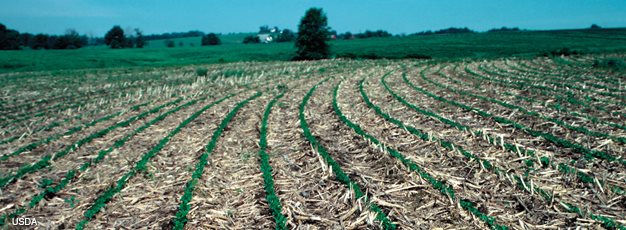No-Till or Strip-Till Use Varies by Region

No-till and strip-till are two of many tillage methods farmers use to plant crops. In a no-till system, farmers plant directly into the undisturbed residue of the previous crop without tillage, except for nutrient injection. In a strip-till system for row crops, seeds are planted into narrow strips (typically 6-8 inches) that were tilled and where fertilizer may also be applied. When compared with conventional or other conservation tillage methods, no-till/strip-till production can reduce soil erosion and sediment loss to water and wind; this helps mitigate sediment loading in bodies of water. It can also increase soil carbon sequestration (the amount of carbon retained in the soil) and improve the physical, chemical, and biological properties of the soil in a number of ways, including increased water-hold capacity, higher soil organic matter content, and reduced soil compaction. Maintaining greater residue on the surface reduces soil temperature, maintains soil moisture, and protects the soil from excessive sunlight and wind.
Farmers who use no-till/strip-till often vary their tillage practices by crop. Farmers may use no-till/strip-till with crops that are well suited for the practices (e.g., soybeans), while using conventional tillage or other conservation tillage methods for crops where no-till/strip-till management are perceived as more risky (e.g., corn). Some farmers may also vary tillage based on field characteristics. For example, farmers may use no-till/strip-till on highly erodible land to control soil erosion. Although tillage practices are not specifically required, they are often part of conservation plans needed to meet eligibility requirements for most Federal agricultural programs, including commodity programs and (after 2014) crop insurance premium subsidies. Weather may also play a role in tillage decisions, as no-till/strip-till is sometimes used to retain soil moisture during droughts.
During 2010-11, roughly 56 percent of all land used for corn, cotton, soybeans, and wheat was located on farms that used no-till/strip-till on at least some portion of this cropland. About 23 percent of land in corn, cotton, soybeans, and wheat was on a farm where no-till/strip-till was used on every acre (full adopters). Another 33 percent of acreage in these crops was located on farms where a mix of no-till, strip-till, and other tillage practices was used (partial adopters). Partial adopters used no-till/strip-till on roughly half of their cropland (15 percent of the four major crops) and other tillage practices on remaining cropland (18 percent of the four major crops). In the Prairie Gateway, Northern Great Plains, and Heartland regions—which account for 72 percent of corn, soybean, wheat, and cotton acreage—56 percent or more of these crop acres were on farms that used no-till/strip-till to some extent. Partial adopters in the Heartland, Prairie Gateway, Eastern Uplands, and Southern Seaboard use no-till/strip-till on 16-20 percent of acres in these crops. Partial adopters have the equipment and expertise, at least for some crops, to use no-till/strip-till but choose to till some portions of their cropland.
Conservation-Practice Adoption Rates Vary Widely by Crop and Region, by Tara Wade, Roger Claassen, and Steven Wallander, USDA, Economic Research Service, December 2015


